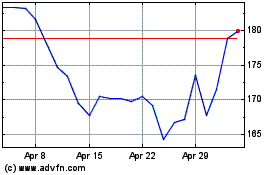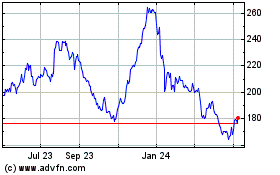By Harriet Torry
WASHINGTON -- The U.S. economic expansion remained on solid
ground as it entered the fourth quarter, although some signs
pointed to weaker consumer spending this holiday season.
An initial snapshot of the year-end trends emerged Wednesday
when the Commerce Department, in separate reports, said household
spending picked up in October and orders for long-lasting factory
goods rose -- both positive signs for growth.
The department also said the U.S. economy expanded at a slightly
better pace than initially estimated in the third quarter, despite
a continuing slump in business investment.
"Growth is still on track" despite recent challenges including a
40-day strike at General Motors Co. and the grounding of Boeing
Co.'s 737 MAX airliner, said Brian Bethune, an economist at Tufts
University.
Investors cheered both the economic data and optimistic comments
Tuesday from President Trump on progress in the trade talks between
China and the U.S., which drove the S&P 500 higher.
Gross domestic product -- the value of all goods and services
produced across the economy -- rose at a 2.1% annual rate in the
third quarter, adjusted for seasonality and inflation, the
department said. That was up from the previous estimate of a 1.9%
pace of growth, mainly due to stronger inventory investment.
The latest reading "indicates the economy is not about to fall
off a cliff," Oxford Economics said in a note to clients. "However,
the lingering global industrial slump, persistent trade policy
uncertainty and cooling income growth all point to weaker activity
in the coming months," economists Gregory Daco and Lydia Boussour
said.
Growth in the fourth quarter, now in its ninth week, is shaping
up to be a bit below the roughly 2% pace seen in the prior two
quarters. Forecasting firm Macroeconomic Advisers on Wednesday
projected GDP would expand at a 1.8% rate in the fourth
quarter.
U.S. shoppers have been the economy's driving force over the
past two quarters as business investment declined. But there are
signs that consumer momentum could be fading. The Commerce
Department said households increased spending a seasonally adjusted
0.3% in October from September, but much of that rise was due to
higher outlays on electricity and gas.
Spending on long-lasting items like vehicles declined in
October, and household incomes were flat overall.
Weakening consumer confidence could also be a cause for concern
as the fourth quarter gets under way. On Tuesday, the Conference
Board reported its consumer confidence index fell in November for
the fourth consecutive month.
Consumer spending accounts for more than two-thirds of total
economic output, and Wednesday's data showed Americans' outlays
grew at a solid, though slower, pace in the July-to-September
period compared with April to June. Personal-consumption
expenditures rose at an unrevised 2.9% annual rate in the third
quarter, compared with 4.6% in the second quarter.
Retailers reporting quarterly sales thus far provide conflicting
views on the health of the American consumer heading into the
pivotal holiday season.
Department-store chains Kohl's Corp., Macy's Inc., Nordstrom
Inc. and J.C. Penney Co. have reported weak sales, but Target
Corp., Amazon.com Inc., Walmart Inc., Best Buy Co. and TJX Co s.
have logged strong gains.
Jamie Lanza, co-founder of Tampa, Fla.-based fitness studio Camp
Tampa, said the back-to-school months of September and October are
typically slower than the earlier months of the year, but
merchandise sales have increased headed into the holidays. "People
are prioritizing things that feel good" like exercise classes, she
said.
Business investment, though, remains a weak spot for the
economy. Nonresidential fixed investment -- which reflects business
spending on software, research and development, equipment and
structures -- fell at a 2.7% annual rate in the third quarter
following a 1% pace of decline in the prior quarter.
U.S. corporate profits also fell in the third quarter, according
to the government's first broad estimate, due in part to legal
settlements with Facebook Inc. and Google parent Alphabet Inc.
A key measure of business earnings -- profit after tax without
inventory valuation and capital-consumption adjustments -- fell
0.6% from the prior quarter after rising 3.3% in the second
quarter. Compared with the third quarter a year earlier, after-tax
profits were down 0.4%.
Paul Miller, vice president of Park Hills, Missouri-based
plastic and rubber product manufacturer MOCAP LLC, said business
has slowed this year, particularly since June. He attributes that
to uncertainty surrounding the U.K.'s exit from the European Union
and the trade dispute with China.
The company's U.S. operation "is kind of holding steady, but
it's just not in growth mode," he said. Still, the company is
planning to build a new factory in Missouri due to savings the
company made from the 2017 tax overhaul, which cut corporate tax
rates and allowed immediate deductions for capital investment.
"For us, the tariffs, yeah they're negative, but the tax savings
were so substantial that it's more of a nuisance, it wasn't
devastating," Mr. Miller said.
One concern posed by weakness in corporate profits is that the
labor market could deteriorate if boardrooms slow hiring or lay off
workers to cut costs, which would likely hit consumer spending.
Still, for now the labor market remains strong. The number of
Americans applying for first-time unemployment benefits fell last
week, the Labor Department said Wednesday. More broadly, the
unemployment rate was a low 3.6% in October and the labor market
continued to add jobs, albeit at a slower pace than in the previous
two months.
Wednesday's reports are unlikely to sway U.S. central-bank
officials from their current wait-and-see stance on monetary
policy.
The Federal Reserve has cut interest rates three times this
year, most recently in October, on worries that weakness in
manufacturing, trade and business investment could threaten the
economic expansion by triggering cutbacks in hiring and consumer
spending.
Officials meet in Washington in two weeks' time for the last
scheduled policy gathering of 2019.
Speaking in Providence, R.I., on Monday, Fed Chairman Jerome
Powell said that "as this expansion continues into its 11th year,
the longest in U.S. history, economic conditions are generally
good."
"If the outlook changes materially, policy will change as well,"
he said.
Write to Harriet Torry at harriet.torry@wsj.com
(END) Dow Jones Newswires
November 27, 2019 14:27 ET (19:27 GMT)
Copyright (c) 2019 Dow Jones & Company, Inc.
Boeing (NYSE:BA)
Historical Stock Chart
From Mar 2024 to Apr 2024

Boeing (NYSE:BA)
Historical Stock Chart
From Apr 2023 to Apr 2024
